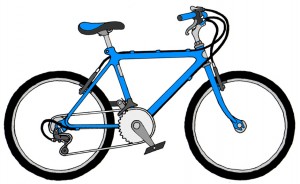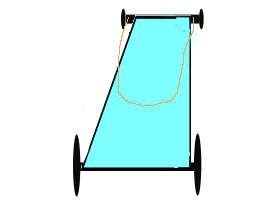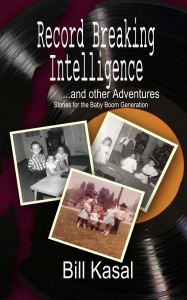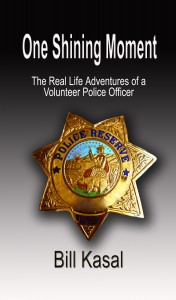Everything is childproofed these days. There are latches for kitchen cupboards and tamper-proof tops for medications. There are mandatory helmet laws for bicycles and seat belt and child-seat laws are strictly enforced. There are safety locks for everything and plastic plugs for the electrical outlets. Disposable lighters have extra buttons that one must manipulate in order to light a candle or cigarette.
Even with all of this, there are still childhood accidents and injuries. But when I think back to the long-ago days of my childhood, I firmly believe I must have had a very diligent Guardian Angel.
There was no such thing as child proofing. When I was born, there were no seat belts in cars. I’m told that when I was two, I stood on the seat next to my father, with my arm resting on his shoulder, as he drove the family car. We played outside. There were no video games. We climbed and built forts and threw dirt clods at each other.
I wasn’t much of an outgoing type. There were others who were more brave and daring than I. I was just… what’s the word? Kind of… ummm… stupid. Yeah, that’s the word. I just tended towards doing stupid things. Those boys and girls who were the daring type—the ones jumping from the roof of the barn with an umbrella and that sort of thing—grew up to be test pilots and astronauts. I grew up to be… what’s the word? Kind of… ummm… stupid. Yeah, that’s the word.
We lived in a rural area and we and our neighbors had horses and chickens and other livestock. There were open fields on either side of our three-house neighborhood and we spent countless hours playing in the sunshine and rain. Well, rain when we could get away with it.
In my book, One Shining Moment, the Real Life Adventures of a Volunteer Police Officer, I write about one event in which I felt God Himself spoke to me and saved me from death or serious injury. It could well have been my Guardian Angel. And that angel protected me often.
My parents, my mother especially, took great care in instructing me towards safe behavior. But when you’re a kid, you always know better. I used to ride my bicycle down to 2nd Street and then over to the main drag to go to the corner market to buy BB’s or some cheap toy or a piece of candy.
The last third of the ride down 2nd Street was a long, downhill grade. I’d pedal my bike as hard as I could and hit the slope going as fast as my legs could pedal me. I could really pick up speed going down that section of the street. Then I’d let gravity due her thing and I’d coast the remaining way to the store.
 I rode on the right, along with traffic. The store was on the opposite side. I’d either have to ride my bike to the intersection and walk my bike across, or I could ride across the street to the opposite side, against traffic for the last part, and coast to a stop in the half-dirt parking area. So, I chose always to swing across the street as I rode and then I could press back on the pedal and skid/slide to a dusty stop.
I rode on the right, along with traffic. The store was on the opposite side. I’d either have to ride my bike to the intersection and walk my bike across, or I could ride across the street to the opposite side, against traffic for the last part, and coast to a stop in the half-dirt parking area. So, I chose always to swing across the street as I rode and then I could press back on the pedal and skid/slide to a dusty stop.
We had no helmets, but my father made me read a pamphlet on bicycle safety before he’d ever have let me ride my bike along the rural streets. There were no sidewalks so most of the time we rode in close proximity to the speeding cars. I was taught to look both ways before walking my bike across a street at any intersection and, if I was going to move to the opposite side of the street, it was drilled into me to always look over my shoulder behind me before I crossed.
Sure. I’d do that. Except, you see, I knew a better way. As I flew the remaining quarter mile down 2nd Street, I could clearly see no one approaching in the oncoming lane. After all, I was facing it. And I’d listen for any cars approaching from behind before swerving, without warning, into the traffic lane and crossing to the other side.
It worked like a charm. I only abruptly swung into the traffic lane if I did not hear a car. And I never did! The problem was that I had chosen, without fail, to swerve when there really were no cars coming. I mean, there had never been a car approaching on those times I chose to dart across the street.
Until one day.
One day I decided to cross to the other side. I heard no cars and, on impulse, swung to my left to cross to the other side. Except, I didn’t move. My tiny brain told my arms to move my handlebars to the left. I even leaned that way, or that is to say, I tried to lean that way. Just as I was wrinkling my brow in surprise at my paralysis, a car sped past me. I hadn’t heard it. I couldn’t hear it with the wind blowing in my ears.
Apparently, every other time I thought that I hadn’t heard a car, it was because there wasn’t a car, not that I hadn’t heard one! This time there had been a speeding car and I would have swerved in front of or into it at a pretty high rate of speed. When I had the impulse to move, the car had been so close that the driver would not have had the opportunity to brake or swerve in time. To this day I am sure I would have seriously injured or killed. And I still believe some otherworldly force or being kept me from crossing at that point.
After the car passed, I then looked behind me and made my crossing. I slowed gradually and stopped at the corner store. I got off my bike and I was shaking. I was probably ten-years-old or less and, even then, I realized disaster had been averted. Never told my mom or dad. Never told anyone. Never crossed the street again without looking behind me.
But I wasn’t always protected from my stupidity. One day, Duane and Bobby and I discovered an old car axle behind Bobby’s barn. It was from some early—and I mean early— model car. The axle had two large, spoke wheels and inflated rubber tires. For some reason it had been fastened with two U-bolts to a two-by-four piece of lumber.
We didn’t hesitate. We first spun the board around the axle and it twirled freely. We then held onto the board and pushed the axle and it moved easily on the wheels. What a bonanza! I have no recollection as to how we came upon the perfect piece of plywood, but it was there. Picture, if you will, a right triangle with the top cut off. It was about three feet wide and about five feet long. The end which would have come to a point had been sawed off, leaving a one foot wide end opposite the bottom. I think the technical name for it is a Right Trapezoid.
 We quickly nailed the two-by-four to the three-foot end of the board, making it the rear of our soon-to-be racer. We scavenged two wheels off of a Radio Flyer wagon and hammered them to the ends of another short two-by-four. We affixed that to the one-foot wide front of our racer with a single nail. You know, so it could pivot! Each end of a long section of rope was also nailed to the top of the two-by-four near the wagon wheels and voila! we had steering.
We quickly nailed the two-by-four to the three-foot end of the board, making it the rear of our soon-to-be racer. We scavenged two wheels off of a Radio Flyer wagon and hammered them to the ends of another short two-by-four. We affixed that to the one-foot wide front of our racer with a single nail. You know, so it could pivot! Each end of a long section of rope was also nailed to the top of the two-by-four near the wagon wheels and voila! we had steering.
We didn’t ask permission. We didn’t explain our idea to anyone. Our racer was ready for a test drive and we pushed and pulled it across one of the adjacent fields over to Reservoir Drive; the next street over. After it crossed Willow Drive, Reservoir made a pretty steep incline until it leveled off. It was perfect. We’d ride our racer down the slope for a quarter mile or so, then level off and slowly come to a stop. It would be perfect since we hadn’t the time to consider a braking system.
We got to the top or the hill on Reservoir and found we had trouble holding our racer in place. This was a ball bearing axle from a real car and it wanted, more than anything, to roll down that hill. I was selected to hold the racer in place while Bobby or Duane, I cannot recall which, sat down and took the loop of rope in his hands. He jerked the right side and then the left to make sure the steering system operated properly. It all looked good. The other sat behind him and wrapped his legs alongside the driver.
I had been holding the rear of the racer in place by grasping the plywood base betwixt my thumbs and fingers. It became instantly obvious that the added weight of Duane and Bobby on the racer made it impossible for me to hold it in place. I was to have gotten on the racer behind the second man but as the car slipped from my grasp, my only option was to leap forward and sit on the back, spinning myself around and facing rearwards with my legs dangling off the back.
The racer raced! The wheels from the antique car sped down the hill. Bobby and Duane yelled with exhilaration. I felt the wind begin to whistle past my ears. We were going fast. We were going faster.
And faster!
Whoever was driving decided to pull over to the shoulder but my weight so far back onto the racer had caused the front wheels to lift slightly off the ground. The steering rope was jerked first to one side and then the next. I didn’t know there was no steering. I didn’t know there was panic growing in the minds of the front passengers. All I knew was that we were going very fast.
I cannot tell you why. I have no idea what came over me. Odds are it was fear or a deep-seated survival instinct. But without a clear, conscious thought, I pushed downward with my hands and lifted myself into the air, jumping from the rear of the speeding racer. When my feet hit the ground, my momentum carried my forward—that is to say, backward—down the hill. I tumbled end over end a few times, scraping elbows and knees and my back; scraping just about every part of me.
I was later told that when I exited the rear of the car, the front end rose slightly and then settled, or, more to the point, slammed into the ground. The wheels, which had last been jerked hard to the right, found traction on the pavement and the racer violently swerved to the right. It turned into the open field and the nose end of the racer dug into the soft, rough clumps of dirt. I didn’t see it, but the racer somehow upended and Bobby and Duane found themselves ejected.
As the dust settled, we all lay on the ground; me still in the street and my two compatriots in the field. It took us a while to bring ourselves to our feet. There may have been tears or there may not. I’m claiming decades-old memories for my inability to remember. There was blood.
Somehow we made it home. Somehow the racer—or fragments thereof—was returned to its place behind Bobby’s barn. And for some reason, when our mothers saw the extent of our injuries and heard the tale of our construction and testing-without-their-knowledge of our racer, we found ourselves grounded for life.
Our sentence was eventually commuted and it took us several debriefings to analyze the cause(s) of our crash. We realized our mistakes but we never, either from fear of another crash but more probably from fear of our mothers, tried to rebuild that racer.
I sometimes wish the child proofers of today could see us in action. I’ll bet they’d faint dead away.



